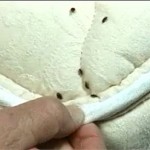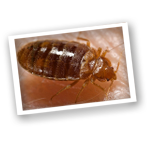[vc_row full_width=”” parallax=”” parallax_image=””][vc_column width=”1/1″][vc_column_text]
Biology
Bed bugs are parasitic, wingless insects, roughly oval in shape, and are fast runners. They are brown to deep red in color as adults, but are a translucent white in their beginning stages of life. Bed bugs also have a thing body that is well adapted for hiding in narrow cracks and crevices, making detection often very difficult.
There are five juvenile stages known as nymphs, which are miniature versions of the adults in appearance. Each nymphal stage requires at least one blood meal to molt to the next stage and it takes 5-10 minutes for complete engorgement to occur. The entire nymphal development takes 6-8 weeks, while the adult bed bugs can live on average for 6-12 months.[/vc_column_text][/vc_column][/vc_row][vc_row full_width=”” parallax=”” parallax_image=””][vc_column width=”1/1″][vc_column_text]
History
Bed bugs originate from the middle east where they first fed on bats in caves. Exemplifying their ability to adapt to their surroundings, bed bugs then moved on to receiving their blood meals from primitive humans. Over time, bed bugs continued to take advantage of nomadic lifestyles and unassuming travelers to make their way across the Old World. And when the first colonists arrived in the Americas, bed bugs did too.
Bed bugs were a major problem until the early 20th century when pesticides such as DDT were developed and used to fight the bed bug population. Bed bugs then became limited to nursery rhymes and areas where these pesticides were not routinely used.
Bed bugs are becoming a problem again because of the outlawing of DDT and other certain pesticides. Bed bugs were given a chance to move freely and repopulate once more. It is suggested that bed bugs are becoming resistant to the pesticides being used against them, and so their populations were naturally on the rise due to this resistance.
[/vc_column_text][/vc_column][/vc_row][vc_row full_width=”” parallax=”” parallax_image=””][vc_column width=”1/1″][vc_column_text]
Identification
Bed bugs are hard to identify with an untrained eye. Bed bugs are a relatively flat bug and are just under 1/4″ long. They tend to move swiftly both horizontal and vertically. Eggs from bed bugs are very small (approximately 1mm ), they are whitish in color, and are difficult to see on most surfaces to the naked eye.
Main Signs of Infestation
- Dark stains on mattress or bedding
- Shed Skins
- Bites that may or may not be itchy, usually occurring in a line on the arms or legs
[/vc_column_text][/vc_column][/vc_row][vc_row full_width=”” parallax=”” parallax_image=””][vc_column width=”1/1″][vc_column_text]
Prevention
You should never bring discarded or used furniture into your residence as it could have been disposed of (although improperly) because it was infested with bed bugs. You should also take precaution against used clothing, luggage, and other previously owned items. Avoiding such items will greatly reduce your risk for bed bugs.
It is easy to suggest to avoid hotels, but it is not a practical one. You shouldn’t avoid travel altogether because of the possibility bed bugs, but you should exercise caution when traveling by checking your hotel’s history with bed bugs, inspecting your room before unpacking, and never putting your luggage on the bed.
With the increase of bed bug infestations in movie theaters, schools, workplaces, and retail stores, it is also a good habit to visually inspect your clothing and personal belongings before entering your residence.
[/vc_column_text][/vc_column][/vc_row][vc_row full_width=”” parallax=”” parallax_image=””][vc_column width=”1/1″][vc_column_text]
Treatment
Can bed bugs be eliminated? Yes, bed bugs can be eliminated, and there are different methods to get rid of them.
The most important step to bed bug removal is using a Bed Bug Certified service provider like that guy. Trying to remove bed bugs on your own is dangerous and often makes the problem worse. Do-It-Yourself treatments are either ineffective or involve the use of dangerous pesticides that should only be used by licensed pest management professionals. Using an at home treatment can be much more hazardous than bed bugs themselves. If you suspect an infestation, call that guy at 800-818-8326 for thorough inspection and treatment
[/vc_column_text][/vc_column][/vc_row]

